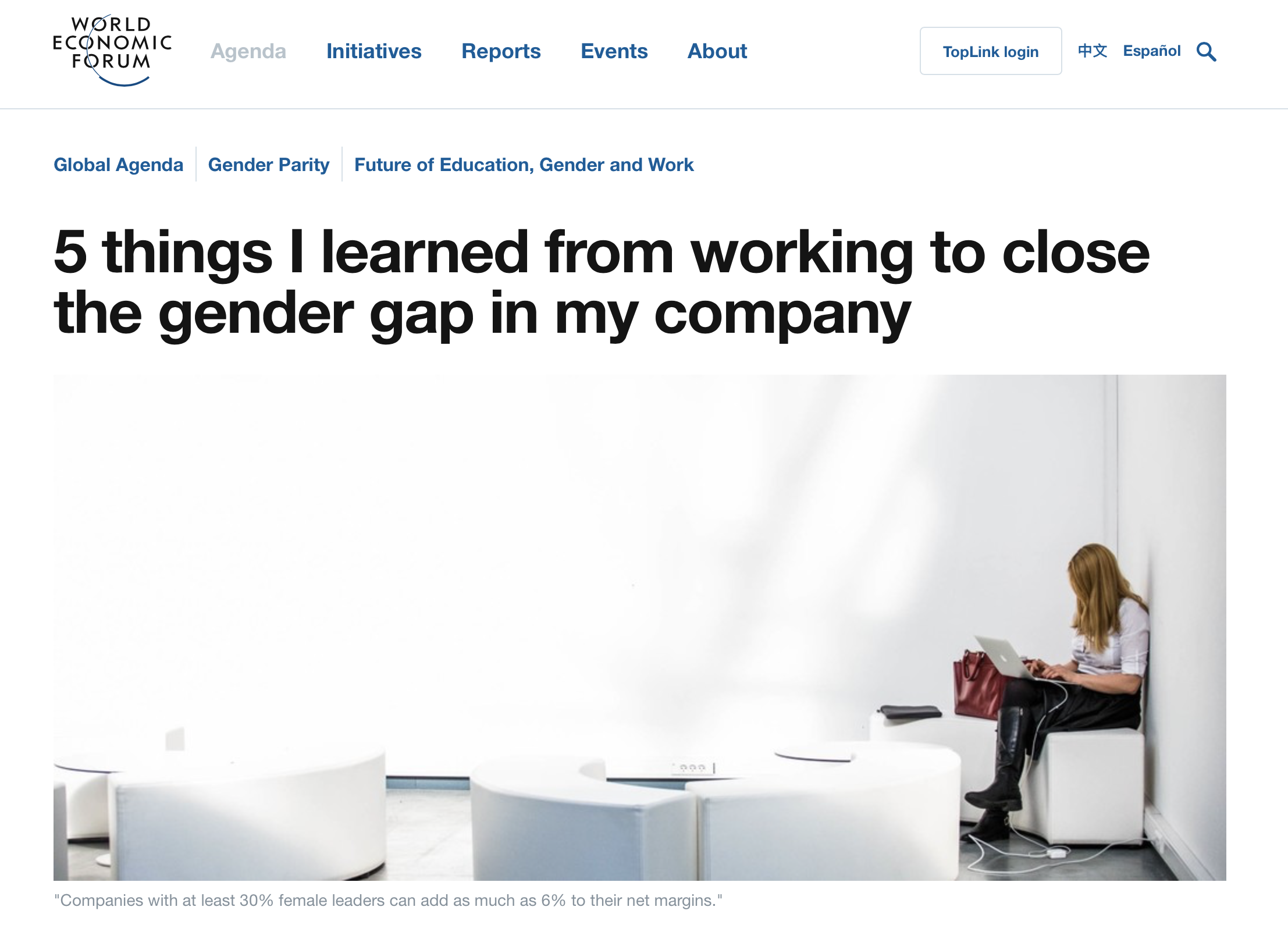UK, June 18, 2017. Doka UK Social Media has already published information on the gender pay gap in the construction sector. Today we bring an interesting reflection from the World Economic Forum. We then reproduce it in full to give way to debate and knowledge.
Every year, the World Economic Forum’s Global Gender Gap Report offers an important opportunity to reflect on the state of gender equality around the world – where we are and how far we still have to go. This year, as always, the results are striking: at the rate we’re currently going, it could take us 170 years – the better part of two centuries – before we see economic parity between women and men.This is a challenge we all need to confront. Because closing the gender gap isn’t just the right thing to do – it’s the smart thing to do for our businesses and the global economy. Our research with the Peterson Institute for International Economics recently found that companies with at least 30% female leaders can add as much as 6% to their net margins. In an internal study we did at EY, we reviewed 22,000 audits around the world, and found that gender-balanced teams didn’t just consistently produce better quality audits – they also had better financial performances overall. At EY, we’ve been on our own path to close the gender gap. These efforts are part of our Vision 2020 business strategy, which also includes our broader goal of advancing diversity and inclusiveness. Over the last few years, we’ve intensified that work by laying out a roadmap for success, which everyone – individuals, teams, and leadership – can use to design, track and advance our progress. We’ve made some important strides, and, just as importantly, we’ve learned a lot along the way.Here are five of the key lessons we’ve learned:

Lesson 1: Measure your gaps – and then measure your results
Closing the gender gap is like any other business challenge: if you want to address a problem, you need to measure it first. That way, you can track your success – and where you still need to improve.
To that end, every year we conduct a Global People Survey to measure our organization’s performance in a number of areas. We also collect quantitative information in areas like hiring, retention and promotion rates. We ask for qualitative feedback, too, like “what do you see as the biggest obstacle to maximizing your potential?”
We’ve found data like this invaluable because it has allowed us to identify “hot spots” – potential areas for improvement. And thanks to the survey, we know that our attention to these “hot spots” is producing results. In the past three years, we’ve taken steps that have equalized the level of satisfaction and engagement between men and women across the organization. But that progress wouldn’t have been possible if we hadn’t measured the gaps to begin with, and held leaders—including myself—accountable.
Lesson 2: Make sure high-potential women have sponsors, mentors and advocates
In every company, executives and senior managers informally sponsor people on the rise in one form or another. Whether it’s someone who showed you the ropes, or an advocate who backed you for a promotion, sponsorship is critical to getting ahead in an organization. Unfortunately, that sponsorship doesn’t always reach everyone – and women are often less likely to be sponsored than men.
We changed that dynamic by supplementing this informal practice with a more formal one: equitable sponsorship. We’ve asked our partners around the world, in every country that we operate in, to sponsor people that don’t look like them, or come from the same background.
These relationships are crucial because they make sure that sponsors aren’t just advisors, but constant supporters. We expect our leaders to go beyond giving advice, making sure their high-potential employees get the experiences and visibility they need to advance in the organization. When there’s an opportunity to expand their portfolio, our leaders help them seize it. We’ve made it clear that this is something our leaders will be evaluated on, because this kind of sponsorship is critical to ensuring our organization’s long-term success.
Lesson 3: The only way to counter unconscious bias is to be conscious of biases
In the competition for talent, we literally can’t afford to pass over talented people in our hiring process. That’s why, whether you’re considering someone for a job or for a promotion, it’s important to find ways to recognize and push back against potential biases.
For example, to make our pool of applicants wider and more diverse, we ask our recruiters and leadership to specifically target nontraditional applicants that might not benefit from informal networks of mentors and connections. We’ve also asked them to remember to balance technical skills with other skills, like language proficiency and cross-cultural awareness. We even organize “unconscious bias” sessions for our recruitment teams and hiring managers, which help remind them to look for and appreciate a wider array of styles and work experiences.
The idea behind all of this is to bring this conversation out into the open. Because the more attention we pay to our potential biases, the more we’ll work to disrupt them – and the less likely we are to be held back by them.
Lesson 4: Focus on men, too
Closing the gender gap doesn’t mean focusing exclusively on women. When you broaden the conversation to include both women and men, it improves opportunities for everyone. When it comes to paternity leave, for example, we know that men can be reluctant to use their benefits. That holds women back, too, by reinforcing the outdated idea that childcare should be mainly the woman’s responsibility – no matter what it means for their careers.
Our research with the Peterson Institute backs this up. We found that countries with the most women in leadership offered fathers 11 times more paternity leave days than countries at the bottom. We also found that the companies with better paternity leave policies are also the ones that are better at building a pipeline of female talent.
That’s why, for example, EY has equalized paternity leave for mothers and fathers in the United States, so both are eligible for 16 weeks of fully paid parental leave. Just as importantly, we have worked hard to create a culture that encourages everyone to take advantage of this new policy. Our leaders – and our in-house coaching team – make it clear that taking your full leave won’t stand in the way of a promotion. In fact, taking your full parental leave aligns with our broader strategy, and is something everyone should support.
It’s the same with our workplace flexibility policies. We have worked hard to create a culture where all of our people feel comfortable using day-to-day flexibility when they need it for things like running to a doctor’s appointment. And for those who need more routine, we introduced Formal Flexible Work Arrangements 10 years ago. We now have about 3,000 employees in the Americas on FWAs, taking advantage of arrangements like reduced schedules, teleworking options, and seasonal schedules. We make sure all of our people feel empowered to take advantage of flexibility, in any of its forms, so they can balance their lives in the way that works best for them.
Lesson 5: Set the tone from the top – and throughout your organization
When we created our Roadmap For Success, we asked every partner to start incorporating measures to increase diversity into their goals every year. But just as importantly, we encouraged all of our leaders to discuss these plans with their teams. We wanted to make it clear that creating an inclusive culture is an organization-wide priority with support from the very top.
Setting the tone in this way is critical for a global organization like ours, because closing the gender gap is not a regional issue, or a local initiative. It’s a central part of our global strategy. It applies to every sector and every country we operate in – so it’s important that all of our people know that all of our leaders are behind it.
That mindset has guided our work in this area. And while we have much more to learn, and much farther to go, we’re proud to be moving forward and doing our part to close the gender gap once and for all.
In this sense, we propose to see the following debate of the World Economic Forum on this topic, but of the year 2010. That is to say, of which was said in this meeting what has been put in place in the last seven years:
Apart from this important contribution to the debate of the World Economic Forum, it would be necessary to check whether there is the same gap between men and women in the digital economy. By the way, during the month of June we are announcing the next opening of the new online shop Doka UK. Soon, we will offer all the features that will surely be useful for your daily professional practice.







